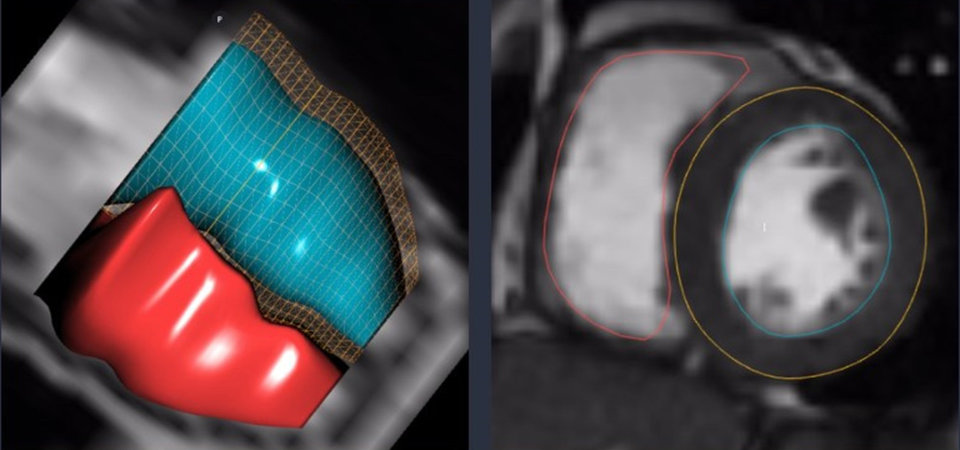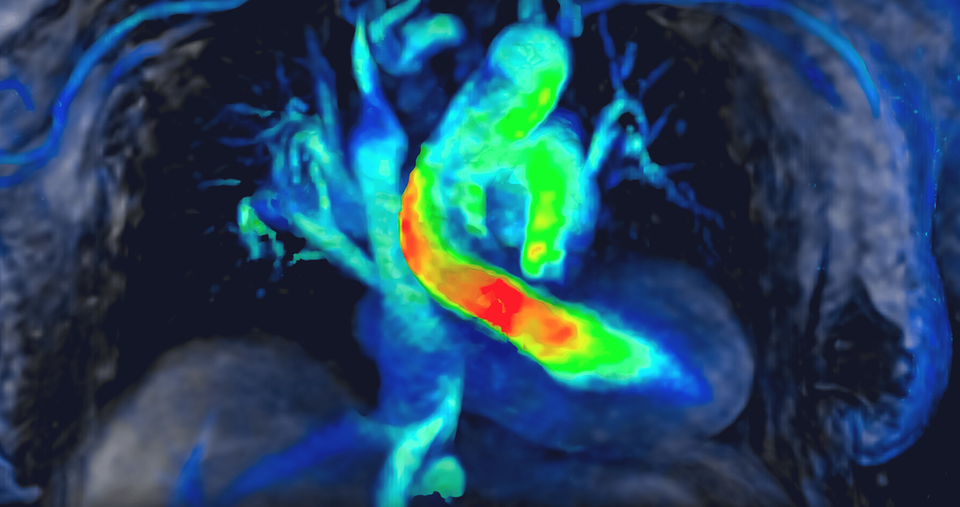Arterys
Cloud
Supercomputing for CMR Big Data
By Gergana Koleva
Fabien Beckers, CEO
Arterys set off on its innovation journey by improving diagnoses for newborns with congenital heart diseases, but now wants to transform heart care for everyone by reducing variability in MR imaging and clinical judgment. It brings to the challenge Stanford-bred expertise in artificial intelligence, cloud computing, and quantifying 4D blood flow – and its next aim is tackling prediction.
Founding of the company
For Arterys, cloud-based AI is a means to an end: moving medical imaging and healthcare data from an offline to an online world. The starting domain of application was cardiac imaging. Envisioned as both a suite of image analysis applications and a data infrastructure, the company´s cardiac software optimizes the processing and rendering of MR images so that diagnoses are made with maximum confidence and speed. The AI algorithms ease the heavy workloads radiologists face by relieving them from having to manually draw circles and contours to assess heart size or make best guesses derived from partial views of the heart. But despite its cutting-edge technology, modelled after distributed server networks of graphics cards, the high usability of Arterys´ platform is designed to appeal to heterogeneous groups of physicians, lab technicians, clinical researchers, and developers, and not only to highly qualified radiologists.
“We are the first company to receive FDA clearance for a cloud deep learning solution. We have a lot of AI models that run in the background to automate functions associated with cardiac imaging and since everything is web-based, it makes our product very easy to use. Within minutes, anyone can connect online, create a log-in password, drag and drop their cases, and have a fully automated workstation at their fingertips from home, from anywhere or from the hospital,” says CEO Fabien Beckers. Arterys is out to democratize highly accurate cardiac diagnoses.
Beckers, who has a PhD in physics, walked into the idea of Arterys after a happenstance meeting with the company´s would-be CTO, John Axerio-Cilies, at Stanford, where Beckerswas pursuing a masters in business and Axerio-Cilies a PhD in engineering in 2010. The business school was running a call for proposals for science-based entrepreneurial projects and they threw their hat in the ring.
“The starting point and the big idea behind Arterys was to really transform health care, especially the imaging vertical, by making it data-driven and online,. The problem that we assessed at the time was that everything was a hundred percent offline. It's really a workstation and a computer underneath the physician desk with very little computing power,” says Beckers, calling the spark that ignited the company´s mission.
After extensive consultations with Stanford clinicians, including the radiologist and computer scientist Albert Hsiao who had written an offline version of code for Arterys´ 4D flow software package, the company emerged on the scene in 2011.

Open AI innovation
Arterys´ Cardio AI solution, an iteration of the code developed by Dr. Hsiao during his residency days at Stanford underneath the mentorship of Dr. Shreyas Vasawala, aids physicians in spotting heart problems by making 4D flow a clinical reality and enabling for the first time clinicians to visualize and quantify blood flow in the heart leveraging a short time MRI sequence (<10min).
The 4d flow solution was completed by a conventional cardiac MRI software solution leveraging the unique computational platform Arterys has built to bring AI and automated the tedious tasks required to process cardiac imaging studies.The software has been found to cut down the average time required to interpret scan results by 25 minutes and to reduce total exam time by up to 30%, helping accelerate some of medicine´s most challenging analysis workflows.
With an already powerful platform in hand, Arterys puts a strong emphasis on continuous innovation and improvement regardless of where novel ideas come from. Keen on engaging global innovators, the company has a dedicated section on its website called Marketplace, where developers anywhere in the world can leverage the Arterys platform to upload their own trained AI models, have others test the models with their data, build and publish AI apps using a deployment environment in hours versus years currently, and collaborate with physicians. All that is needed to set the magic in motion is a Chrome browser and an internet connection.
“Every day we have people reaching out to us with new ideas not just in the product space, but broader than that. I think this is the most exciting part of being a true open innovation platform for healthcare, as it will open the door to so many clinicians expressing their needs and developers responding to those needs and producing things, and both of them connecting on Arterys, testing, and iterating. For the first time we can really apply the power of the internet to clinical care and reduce the friction that is currently present for that value to be easily available, which has never been the case before,” says Beckers.
The readiness with which Arterys embraces crowdsourced innovation reflects its goal of building a community of collaborators across institutional and geographical silos. Beckers considers this aspect of the company´s culture a differentiating advantage in the fiercely competitive medtech space, where players tend to anxiously guard their data. He sees in the resulting cross-pollination of ideas a sum greater than its parts: “We see a unique vision where clinicians can collaborate on a single global online platform, data is shared in a click, computation is limitless, diagnoses are automated and predictive and accessibility is for everyone. Collaboration around AI is extremely valuable for us as a platform, because it brings researchers and physicians propagating together. Bringing the world of healthcare together on one platform is really the long-term vision we are aspiring to achieve.”
Product differentiation
Apart from its capacity to handle exponential volumes of CMR data, its ease of use without a need for advanced technical training, and its openness to outside-in innovation, Arterys´ cloud-based AI platform can connect to many clinical sites at a time, thus speeding the simultaneous evaluation of multiple CMR cases. The software releases fortnightly upgrades, which put the company head and shoulders above on-premise computer networks that are typically upgraded biannually.
“Compared to conventional MRI processing, which goes at a very low-volume pace, our solution can connect to multiple sites and bring that expertise to more hospitals. But what I think makes our solution truly unique is the capability to bring AI within a clinical workflow. AI without a clinical workflow is unusable and it´s also hard to create a workflow tailored to each AI, but through our marketplace clinicians and radiologists have access to hundreds of AI applications so they can build their own workflow if they wanted to. Plus, they always have new features and new capabilities without necessarily having to pay for them. That´s our unique advantage from an infrastructure point of view,” says Beckers.
As far as what the future holds for Arterys, the company – whose software can be sold in more than 100 countries – is aiming for the stars. Or at least for moving from mastering the post-processing world to mastering prediction, arguably the most difficult piece of personalized medicine for both doctors and algorithms. Beckers says his team is three or four years into ideating and preparing for this next phase.
“There are so many AI applications that are possible to create now on a pure detection, computation, and quantification level that people are working on the easy part first. But I'm always very interested and fascinated by working on prediction, because I think that's the most transformative piece. I think as an industry we're just in the early phase of it, and I think Arterys will accelerate the next 3-5 years into two years.”

Cloud-based platform
4D flow MRI
Arterys´ industry-leading AI solution is complemented by a cloud platform designed for processing large cardiac imaging files that exceed the computational power and storage capabilities of most hospital computer networks. Illustrating the limitations of legacy enterprise systems, one of the most heralded technologies used today in cardiac MR, 4D flow, captures data sequences that can reach up to 10 gigabytes in size, but clinicians are confined to only partial views of these high-dimensional scans due to the insufficient bandwidth of local machines to load the full images.
“A lot of the time physicians don't have enough computers on premises to process the size of the data that the 4D flow requires, so they can only see a small portion of the heart or the ventricles. With a cloud-based solution that can render the full chest or even the whole body online, they can see everything with a much better speed and much better features because the amount of computation available behind the scenes,” says Beckers, explaining the technological gap Arterys seeks to address. He notes that the capability to process computationally intensive images can be a game changer in radiology, yet it is an area too few healthcare innovators focus on – and one where Arterys clearly stands out.
The company´s cloud-based CMR management solution was developed symbiotically with another crucial decision it made as its vision of transforming medicine into a less subjective and more data-driven practice was taking shape. Beckers and his co-founders has identified 4D flow – named so because it encompasses 3D plus time – as a superior technique to cardiac ultrasound, which would correct for the latter´s shortcomings. Providing a web-based infrastructure, while an appealing proposition in itself, was a necessary condition for being able to process the much larger 4D flow data files.
“In the heart environment, we realized that using ultrasound resulted in very subjective diagnoses. It´s not quantitative and there´s a lot of error due to the lack of precision of the tool, especially in getting blood flow. As a result of that, we felt that 4D flow, which was developed by two other Stanford physicians, was a prime candidate for the first application of our thesis of making medicine more data-driven,” says Beckers.
Nestled within the platform´s cardiac AI software, Arterys´ 4D flow technique allows physicians to measure and visualize blood patterns relative to all three dimensions of space plus time along the cardiac cycle. It identifies cardiac landmines and detects forward flow, reverse flow, net flow, peak velocity, and pressure gradient in any region of interest, all delivered in what the company describes as “breathtaking graphics.”


We have a lot of AI models that run in the background to automate functions associated with cardiac imaging and since everything it web-based, it makes our product very easy to use. Within five minutes, anyone can connect online, create a log-in password, drag and drop their cases, and have a fully automated workstation at their fingertips from home or from the hospital.
Fabien Beckers, CEO, Arterys
Trained on more than 1,000 real use cases using supervised deep learning, Arterys´ Cardio AI solution dives into MRIs to find patterns and associations between the data and cardiovascular disease that are invisible to the clinical eye or untraceable using conventional variables. The software has been found to cut down the average time required to interpret scan results by 25 minutes and to reduce total exam time by up to 30%, helping accelerate some of medicine´s most challenging analysis workflows